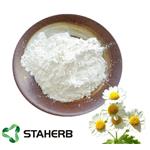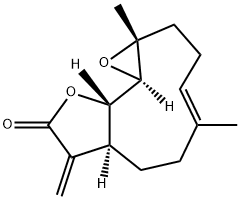Parthenolide
- CAS No.
- 20554-84-1
- Chemical Name:
- Parthenolide
- Synonyms
- PTL;Nsc157035;Aids007764;Parthelide;Aids-007764;Parthenolide;PartheNAlide;Parthenolides;parthenolider;Parthenolide>
- CBNumber:
- CB0446848
- Molecular Formula:
- C15H20O3
- Molecular Weight:
- 248.32
- MDL Number:
- MFCD00134592
- MOL File:
- 20554-84-1.mol
- MSDS File:
- SDS
| Melting point | 115-116 °C (lit.) |
|---|---|
| alpha | D20 -81.4° (c = 1.04 in chloroform); D22 -71.4° (c = 0.220 in CH2Cl2) |
| Boiling point | 394.1±42.0 °C(Predicted) |
| Density | 1.13±0.1 g/cm3(Predicted) |
| storage temp. | -20°C |
| solubility | Soluble in DMSO (up to 100 mg/ml) or in Ethanol (up to 20 mg/ml) |
| form | White solid |
| color | White |
| Merck | 14,7048 |
| Stability | Stable for 1 year from date of purchase as supplied. Solutions in DMSO or ethanol may be stored at -20° for up to 3 months. |
| InChI | InChI=1S/C15H20O3/c1-9-5-4-8-15(3)13(18-15)12-11(7-6-9)10(2)14(16)17-12/h5,11-13H,2,4,6-8H2,1,3H3/b9-5+/t11-,12-,13+,15+/m0/s1 |
| InChIKey | KTEXNACQROZXEV-PVLRGYAZSA-N |
| SMILES | O1C(=O)C(=C)[C@]2([H])CCC(C)=CCC[C@@]3(C)O[C@]3([H])[C@@]12[H] |t:10| |
| LogP | 2.424 (est) |
| CAS DataBase Reference | 20554-84-1 |
| FDA UNII | 2RDB26I5ZB |
SAFETY
Risk and Safety Statements
| Symbol(GHS) |  GHS07 |
|---|---|
| Signal word | Warning |
| Hazard statements | H317 |
| Precautionary statements | P280-P302+P352 |
| Hazard Codes | Xi,C,F |
| Risk Statements | 11-34 |
| Safety Statements | 22-24/25-45-36/37/39-26-16 |
| WGK Germany | 3 |
| RTECS | LY4220000 |
| HS Code | 29322090 |
Parthenolide price More Price(52)
| Manufacturer | Product number | Product description | CAS number | Packaging | Price | Updated | Buy |
|---|---|---|---|---|---|---|---|
| Sigma-Aldrich | PHL89255 | Parthenolide phyproof? Reference Substance | 20554-84-1 | 20MG | $288 | 2024-03-01 | Buy |
| Sigma-Aldrich | 512732 | Parthenolide | 20554-84-1 | 50mg | $99.4 | 2024-03-01 | Buy |
| Sigma-Aldrich | 1500400 | Parthenolide United States Pharmacopeia (USP) Reference Standard | 20554-84-1 | 25mg | $240 | 2024-03-01 | Buy |
| TCI Chemical | P1982 | Parthenolide >97.0%(HPLC) | 20554-84-1 | 25mg | $87 | 2024-03-01 | Buy |
| TCI Chemical | P1982 | Parthenolide >97.0%(HPLC) | 20554-84-1 | 100mg | $258 | 2024-03-01 | Buy |
Parthenolide Chemical Properties,Uses,Production
Description
(-)-Parthenolide (PTL) is a natural sesquiterpene lactone produced as a secondary metabolite by plants of the Asteraceae/ Compositae (daisies) and Magnoliaceae family (magnolias). It was first isolated from feverfew (Tanacetum parthenium L. Schulz Bip. or synonymously Chrysanthemum parthenium L. Bernh.). The plant owes its name to its use as a long known natural remedy for alleviating fever, migraine, rheumatoid arthritis, stomach ache, toothache, and insect bites, among other ailments. After it was shown that parthenolide is the main biologically active ingredient of these plant(s)1b, many studies have described promising anti-inflammatory and anti-tumour properties of the natural product. Interestingly, it was shown that PTL was cytotoxic to tumor cells while almost not affecting healthy cells at similar concentrations. Moreover, it was reported to be one of the few small molecules that selectively target cancer stem cells, which are still difficult to treat and a suspected reason for tumour relapse[6].
Chemical Properties
White solid
Uses
Antiinflammatory;MAP kinase inhibitor
Uses
Parthenolide is an anti-inflammatory agent used in the treatment of ischemic injury. Also acts as an anti-tumor and anti0leukemia agent targetting acute myeloid leukemia.
Uses
Parthenolide is a sesquiterpene lactone from the plant feverfew (T. parthenium). It inhibits the growth of the promastigote form of L. amazonensis (IC50 = 3.6 μg/ml). Parthenolide also induces apoptosis in cancer cells, at least in part by inhibiting NF-κB- and STAT-mediated anti-apoptotic gene transcription. This compound has also been shown to block inflammation by inhibiting signaling through NF-κB. Inhibition of NF-κB by parthenolide can be achieved by direct binding of the pattern recognition receptor NOD2 by parthenolide.
Definition
ChEBI: Parthenolide is a sesquiterpene lactone and active principle of Feverfew (Tanacetum parthenium). It has a role as a non-steroidal anti-inflammatory drug, a non-narcotic analgesic, a peripheral nervous system drug, an inhibitor and a drug allergen.
General Description
This substance is a primary reference substance with assigned absolute purity (considering chromatographic purity, water, residual solvents, inorganic impurities). The exact value can be found on the certificate. Produced by PhytoLab GmbH & Co. KG
Biological Activity
The active principle of feverfew (Chrysanthemum parthenium), widely used as a herbal remedy for arthritis and migraine and as a febrifuge. Parthenolide is antisecretory, anti-inflammatory, spasmolytic and inhibits the release of 5-HT from blood platelets. Also inhibits generation of leukotriene B 4 and thromboxane B 2 .
Biochem/physiol Actions
Parthenolide is a sesquiterpene lactone present abundantly in the leaves and flowers of Tanacetum parthenium. It exhibits anti-cancer properties for the treatment of invasive cancers. Parthenolide exhibits therapeutic effects against inflammation and migraine. It plays a role in signal transduction and activation of transcription (STAT)-inhibition-mediated transcriptional repression of pro-apoptotic genes.
Contact allergens
Parthenolide is a sesquiterpene lactone found Asteraceae- Compositae such as feverfew (Tanacetum parthenium Schultz-Bip.) or congress grass (Parthenium hysterophorus L.).
Mechanism of action
Parthenolide (PTL) is a potent NF-κB signaling inhibitor that exerts anti-inflammatory effects by inhibiting IκBα depletion, thereby inhibiting excessive NF-κB activation. It also inhibits the nuclear translocation of the p65 subunit and the DNA binding of the NF-κB complex to exert anti-tumor effects. In addition, it inhibits STAT and MAP kinase activity and induces sustained JNK activity and p53 activity by affecting MDM2 and HDAC1 levels, resulting in increased sensitivity of cancer cells to chemotherapy and radiotherapy. The most unique property is that it can induce cell death mainly in cancer cells while sparing healthy cells, and it also protects normal cells from UVB and oxidative stress.
References
1) Kwok et al. (2001), The anti-inflammatory natural product parthenolide from the medicinal herb Feverfew directly binds to and inhibits IkappaB kinase; Chem. Biol., 8 759
2) Hwang et al. (1996), Inhibition of the expression of inducible cyclooxygenase and proinflammatory cytokines by sequiterpene lactones in macrophages correlates with the inhibition of MAP kinases; Biochem. Biophys. Res. Commun., 226 810
3) Barsby et al. (1992), Feverfew extracts and parthenolide irreversibly inhibit vascular responses of the rabbit aorta; J. Pharm. Pharmacol., 44 737
4) Sumner et al. (1992), Inhibition of 5-lipoxygenase and cyclo-oxygenase in leukocytes by feverfew. Involvement of sesquiterpene lactones and other components; Biochem. Pharmacol., 43 2313
5) Groenewegen et al. (1990), A comparison of the effects of an extract of feverfew and parthenolide, a component of feverfew, on human platelet activity in-vitro; J. Pharm. Pharmacol., 42 553
6) Freund, Robert R. A. et al. “Advances in chemistry and bioactivity of parthenolide?.” Natural Product Reports 4 (2019): 541–565.
Parthenolide Preparation Products And Raw materials
Raw materials
Preparation Products
| Supplier | Tel | Country | ProdList | Advantage | |
|---|---|---|---|---|---|
| Accendatech Co., Ltd. | +8613132578992 | yunhao.liu@accendatech.com | China | 251 | 58 |
| Hebei Weibang Biotechnology Co., Ltd | +8615531157085 | abby@weibangbio.com | China | 8806 | 58 |
| Hebei Mujin Biotechnology Co.,Ltd | +86 13288715578 +8613288715578 | sales@hbmojin.com | China | 12832 | 58 |
| Hebei Kingfiner Technology Development Co.Ltd | +86-15532196582 +86-15373005021 | lisa@kingfinertech.com | China | 3009 | 58 |
| Shaanxi Haibo Biotechnology Co., Ltd | +undefined18602966907 | qinhe02@xaltbio.com | China | 997 | 58 |
| Henan Fengda Chemical Co., Ltd | +86-371-86557731 +86-13613820652 | info@fdachem.com | China | 20274 | 58 |
| Shanghai Zheyan Biotech Co., Ltd. | 18017610038 | zheyansh@163.com | CHINA | 3619 | 58 |
| career henan chemical co | +86-0371-86658258 +8613203830695 | sales@coreychem.com | China | 29880 | 58 |
| Biochempartner | 0086-13720134139 | candy@biochempartner.com | CHINA | 965 | 58 |
| Chengdu Biopurify Phytochemicals Ltd. | +8618080483897 | sales@biopurify.com | China | 3772 | 58 |
View Lastest Price from Parthenolide manufacturers
| Image | Update time | Product | Price | Min. Order | Purity | Supply Ability | Manufacturer | |
|---|---|---|---|---|---|---|---|---|
 |
2025-01-10 | Parthenolide; Tanacetum parthenium
20554-84-1
|
US $0.00 / KG | 1KG | 1%-98% HPLC | 1000KG | Changsha Staherb Natural Ingredients Co., Ltd. | |
 |
2024-11-27 | Parthenolide
20554-84-1
|
US $10.00 / KG | 1KG | 99% | 10 mt | Hebei Weibang Biotechnology Co., Ltd | |
 |
2024-11-19 | Parthenolide
20554-84-1
|
US $50.00-68.00 / mg | 99.46% | 10g | TargetMol Chemicals Inc. |
-

- Parthenolide; Tanacetum parthenium
20554-84-1
- US $0.00 / KG
- 1%-98% HPLC
- Changsha Staherb Natural Ingredients Co., Ltd.
-

- Parthenolide
20554-84-1
- US $10.00 / KG
- 99%
- Hebei Weibang Biotechnology Co., Ltd
-

- Parthenolide
20554-84-1
- US $50.00-68.00 / mg
- 99.46%
- TargetMol Chemicals Inc.





